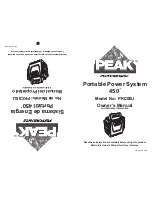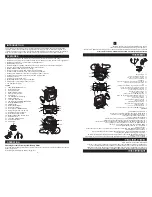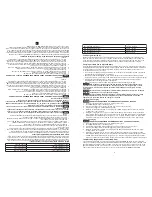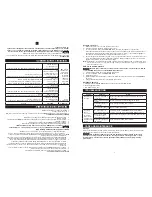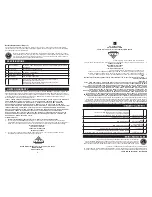
3
Antes de reciclar o desechar la batería, proteja los terminales descubier
tos con cinta aislante eléctrica
•
para e
vitar cortocircuitos (cor
tocircuitos puede resultar en heridas cor
porales o en un incendio).
Cuando use este producto, siempre use gaf
as para proteger los ojos
. El contacto con el ácido de la
•
batería podrá causar ceguera y/o quemadur
as químicas seve
ra
s.
Siga estos procedimientos de primeros auxilios en caso de contacto accidental con ácido de batería.
•
PRIMEROS A
UXILIOS
PIEL:
Lávese la piel completamente si el ácido de batería entr
a en contacto con la piel. Obtenga
inmediatamente atención médica.
OJOS:
Enjuáguese los ojos con agua fría dur
ante por lo menos diez minutos
. Obtenga inmediatamente
atención médica.
SI SE INGIERE, PÓNGASE INMEDIA
T AMENTE EN CONT
AC
TO
CON UN CENTRO DE CONTR
OL DE ENVENENAMIENTO
.
Nunca toque las pinzas de la batería entre sí o contra un pedaz
o de metal común. P
odrá resultar en
•
chispas, e
xplosión o daños a la unidad. Después de usar las pinzas
, guárdelas siempre en los montantes
ubicados en la parte tr
asera de la unidad.
Coloque esta unidad tan lejos de la batería que se esta cargando como lo permitan los cab
les de carga.
•
Cuando use el Sistema de Energía Po
rtátil cerca de la batería y del motor del v
ehículo, coloque la unidad
•
sobre una superfi cie plana y estab
le, mantenga todas las pinzas
, cordones, ropa y par
tes del cuerpo
alejados de las piezas en movimiento del v
ehículo.
Siga estas instrucciones y aquellas pub
licadas por el fabr
icante de la batería y por el fabr
icante de
•
cualquier equipo que usted intente usar cerca de la batería. Antes de cargar
, préstele atención a las
precauciones de peligro en estos productos y en el motor
.
Este sistema fue diseñado para ser usado sólo en v
ehículos con sistema de batería de 12 voltios CC
.
•
No
lo conecte
a un sistema de batería de 6 ó 24 voltios
.
Quítese todas las joyas y objetos metálicos que pudier
an causar cortocircuitos o reaccionar con el ácido
•
de la batería. Una batería de plomo-ácido produce una corr
iente de cortocircuito sufi
cientemente alta
como para soldar un anillo u otro objeto similar al metal, causando una quemadur
a seve
ra
.
Cuando trabaje en equipos eléctr
icos, siempre tenga a alguien cerca par
a que lo ayude en caso de una
•
emergencia.
Mantenga a mano una buena cantidad de carbonato de sodio (baking soda) cuando tr
abaje con baterías.
•
El carbonato de sodio neutraliza el electrolito de las baterías de plomo-ácido
.
AVISO
T
odos los mensajes que siguen tiene niveles de peligro de A
VISO. El no cumplir puede
resultar en daños a la propiedad.
Los vehículos que tiene sistemas computar
izados a bordo pueden sufrir daños si la batería del v
ehículo
•
es arrancada con cab
les de puente. Antes de arr
ancar con cables de puente
, lea el manual del
propietario del v
ehículo para confi
rmar si la asistencia de arr
anque exter
na es apropiada.
El darle arr
anque excesiv
amente al motor puede dañar el motor de arranque
. Si el motor f
alla en
•
arrancar después de el número recomendado de intentos
, descontinúe el procedimiento de arranque con
cables de puente y b
usque otros problemas que necesiten ser corregidos
.
Este Sistema de Energía Po
rtátil
•
no fue diseñado
para que se use como reemplaz
o de la batería del
vehículo
.
No intente
operar un v
ehículo que no tenga una batería instalada.
Después de conectar las pinzas de carga de batería en la batería descargada y antes de encender el
•
interruptor de ON/OFF de arr
anque con cables de puente
, ve
rifi
que la luz del indicador de energía/
polaridad ubicada en el frente de la unidad.
Si la luz se enciende en VERDE, las cone
xiones de las
pinzas están correctas. Si la luz se enciende en R
OJO y la alarma suena, las cone
xiones de las pinzas
están incorrectas y necesitan ser inve
rtidas
.
Este Sistema de Energía Po
rtátil se entrega en un estado de carga parcial.
Cargue completamente la
•
unidad con el cargador de 110/120 voltios CA suministr
ado, al máximo recomendado y tiempo de carga
inicial de 36 horas
. En lo sucesiv
o, un tiempo de carga CA típico es de 18 a 24 hor
as cuando se usa el
cargador de CA.
No exceda
•
el máximo recomendado y el tiempo de carga inicial de 24 horas usando el método de 12
voltios CC
.
Aunque esta unidad contiene una batería sellada, se recomienda que la unidad sea mantenida de pie
•
durante su almacenaje
, uso y recarga. P
ara
evitar posib
les daños que le pueden acortar la vida de
trabajo a la unidad, protéjala de la luz solar directa, calor directo y/o humedad.
Nunca permita que el ácido de batería entre en contacto con esta unidad.
•
T odos los interr
uptores de ON/OFF deben estar en la posición OFF cuando el Sistema de Energía
•
Po
rtátil esté siendo cargado o no esté siendo usado
. Asegúrese de que todos los interr
uptores estén en
la posición OFF antes de conectar la unidad a una fuente de energía o carga.
No deje el compresor desatendido mientras está oper
ando. El compresor fue diseñado sólo par
a
•
operación de cor
to tiempo. La oper
ación del compresor durante un período de tiempo e
xtenso causará
que la unidad del compresor se recaliente pudiendo causar daños. Deje que el compresor se enfríe
durante 10 min
utos después de operar
lo continuamente por un período e
xtenso.
No use ningún accesorio que no sea recomendado o suministr
ado por el fabr
icante.
•
3
Do not expose battery to fi re or intense heat, since it can explode.
•
Before recycling or disposing of a battery, protect exposed terminals with heavy-duty electrical tape to
•
prevent shorting (shorting can result in personal injury or fi re).
Always wear protective eyewear when using this product. Contact with battery acid can cause blindness
•
and/or severe chemical burns.
Follow these fi rst aid procedures in case of accidental contact with battery acid.
•
FIRST AID
SKIN:
Wash skin thoroughly if battery acid comes in contact with skin. Seek medical attention
immediately.
EYES:
Flush eyes with cool water for at least ten minutes. Seek medical attention immediately.
CONTACT POISON CONTROL CENTER IMMEDIATELY IF INGESTED.
Never touch battery clamps together or to a common piece of metal. Sparking, explosion, or damage to
•
the unit can result. Always store the battery clamps on the appropriate case clamp posts on the back of
the unit after use.
Place this unit as far away from the battery being charged as the charging cables will permit.
•
When using the Portable Power System close to the vehicle’s battery and engine, place the unit on a fl at,
•
stable surface, and keep all clamps, cords, clothing and body parts away from moving parts of the vehicle.
Follow these instructions and those published by the battery manufacturer and manufacturer of any
•
equipment you intend to use near the battery. Pay attention to all hazard precautions on these products
and on the engine before charging.
This system is designed to be used only on vehicles with a 12-volt DC battery system. Do
•
not
connect to
a 6-volt or 24-volt battery system.
Remove all jewelry or metal objects that could cause short circuits or react with battery acid. A lead-acid
•
battery produces a short circuit current high enough to weld a ring or other similar objects to metal, causing
a severe burn.
When working on electrical equipment, always ensure someone is nearby to help you in an emergency.
•
Keep a supply of baking soda on hand when working on batteries. Baking soda neutralizes lead-acid
•
battery electrolyte.
All messages that follow have NOTICE level hazards. Failure to comply could result in
property damage.
Vehicles that have on-board computerized systems may be damaged if vehicle battery is jump-started.
•
Before jump-starting, read the vehicle’s owner’s manual to confi rm that external-starting assistance is
suitable.
Excessive engine cranking can damage a vehicle’s starter motor. If the engine fails to start after the
•
recommended number of attempts, discontinue these jump-start procedures and look for other problems
that may need to be corrected.
This Portable Power System is
•
not
designed to be used as a replacement for a vehicle’s battery. Do
not
attempt to operate a vehicle that does not have a battery installed.
After connecting the battery charging clamps to the discharged battery and before turning on the jump-
•
starter ON/OFF switch, check the power/polarity indicator light on the front of the unit. If the light turns
GREEN, the clamp connections are correct. If the light turns RED and an alarm sounds, the clamp
connections are incorrect and need to be reversed.
This Portable Power System is delivered in a partially charged state. Fully charge unit with the supplied
•
110/120-volt AC charger to the recommended maximum and initial charge time of 36 hours. Thereafter,
an AC typical charge time is 18 to 24 hours when using the AC charger.
Do
•
not
exceed the recommended maximum and initial DC charge time of 24 hours using the 12-volt DC
method.
Although this unit contains a sealed battery, it is recommended that the unit be kept upright during
•
storage, use and recharging. To avoid possible damage that may shorten the unit’s working life, protect it
from direct sunlight, direct heat and/or moisture.
Never allow battery acid to come in contact with this unit.
•
All ON/OFF switches should be in the OFF position when charging the Portable Power System or when
•
not in use. Make sure all switches are in the OFF position before connecting to a power source or load.
Do not leave the compressor unattended while operating. The compressor is designed for short-term
•
operation only. Operation of the compressor over an extended period of time will cause the compressor
unit to overheat and may cause damage. Allow the compressor to cool down for 10 minutes after
extended periods of continuous operation.
Do not use any accessory that is not recommended or provided by the manufacturer.
•

